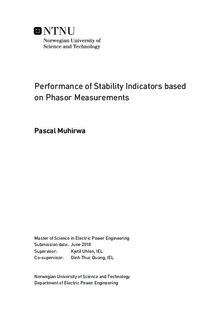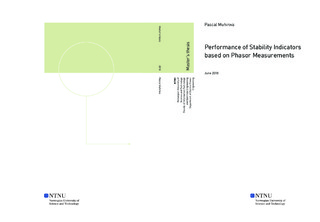| dc.description.abstract | The development of Wide Area Measurements (WAMS) is growing with the increasing usage of Phasor Measurements Units(PMU) in power systems. Its introduction gives power system operators greater observability, as PMUs can measure the voltage angle and magnitude in real time (up to 50/60 recordings per second), with the help of GPS technology. Given better situational awareness, system operators gain a higher chance of preventing unstable or insecure operation of the power system. The applications of PMU measurements are many, on the subject of power system stability the availability of using PMU measurements makes it possible to estimate system modal characteristics directly from the measurements. System identification and signal processing method has in the last decades been studied and customized for power system application, particularity to estimate modal properties in power systems.
The objective of this thesis is to assess the performance of two algorithms which are commonly used in the structure and civil engineering for modal estimation. The two methods investigated in this report, are the Natural Excitation Technique used in conjunction with Eigensystem Realization Algorithm (NExT-ERA) and Multivariate Auto-regressive model(MAR). The NexT-ERA is a twofold algorithm. The first algorithm, The Natural Excitation Technique, can estimate impulse responses of power systems by calculating cross-correlation functions between measurement. The second algorithm, Eigensystem Realization Algorithm, uses the impulse responses calculated with NExT to estimate a state-space model of the power system. From the state matrix, the eigenvalues which describes the dynamic of the system can thus be extracted. Multivariate Auto-regressive model is an extension of the Auto-regressive model which uses multiple signals to fit into the model. The modal properties can be calculated by the parameters of the MAR model by eigendecomposition.
This thesis shows that the methods can estimate the electromechanical modes, which correspond to low-frequency oscillations that are excited by continuously varying loads. The performance of the methods is investigated by comparing prior knowledge of the modal properties from a synthetic signal, simulation model and the Nordic power grid with estimated values. The evaluation of the performance of the methods is based on the consistency of the estimation for different window length and model order. The evaluated results are designated to give the reader input on how NExT-ERA and MAR perform as a stability indicator for power systems. Which may motivate the reader to implement and study the method further with the intent to create an application for real-time and off-line modal identification. | |

